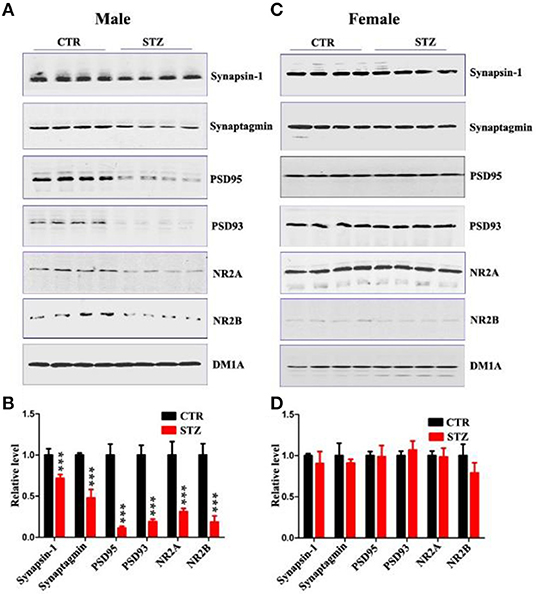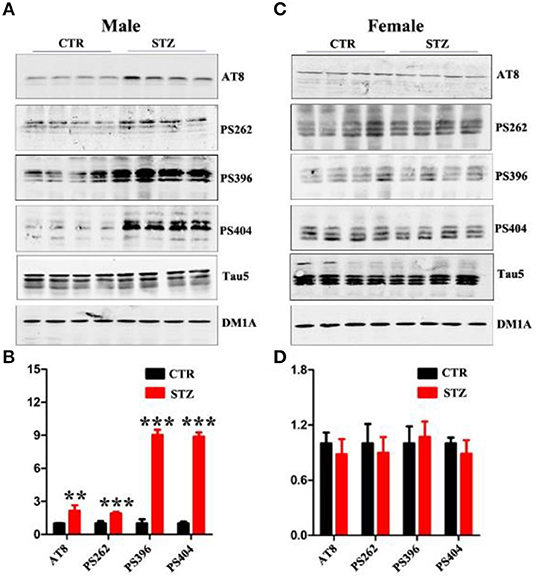- 1Key Laboratory of Ministry of Education of China for Neurological Disorders, Department of Pathophysiology, School of Basic Medicine and the Collaborative Innovation Center for Brain Science, Tongji Medical College, Huazhong University of Science and Technology, Wuhan, China
- 2Co-innovation Center of Neuroregeneration, Nantong University, Nantong, China
- 3School of Medicine and Health Management, Tongji Medical College, Huazhong University of Science and Technology, Wuhan, China
- 4Department of Genetics and Genomic Sciences, Icahn School of Medicine at Mount Sinai, New York, NY, United States
A Corrigendum on
Sex Differences in the Cognitive and Hippocampal Effects of Streptozotocin in an Animal Model of Sporadic AD
by Bao, J., Mahaman, Y. A. R., Liu, R., Wang, J.-Z., Zhang, Z., Zhang, B., et al. (2017). Front. Aging Neurosci. 9:347. doi: 10.3389/fnagi.2017.00347
In the original article, due to the authors' oversight, there were several mistakes in Figure 3C and Figure 4C as published. The image “PSD95 of Female” in Figure 3C was inadvertently replaced with the image “GSK3β” in Figure 5C. The images “AT8 of Female” and “PS262 of Female” in Figure 4C were inadvertently replaced with image “PS404 of Female” from Figure 4C. The image “Tau5 of Female” in Figure 4C was inadvertently replaced with image “Tau5 of Male” in Figure 4A. The corrected Figures 3C and 4C appear below. The quantification for the above-mentioned blots have been done in the corrected Figures 3D and 4D, which all have no significant difference between control and STZ groups as in the published original version of the article.

Figure 3. Sex influences synaptic plasticity in the sporadic AD animal model. (A,C) Western blot analysis of the protein levels of synapsin-1, synaptagmin, psd95, psd93, NR2A, and NR2B and (B,D) their quantitative analysis for male or female rats. DM1A was used as a loading control. The data were expressed as mean ± SD (n = 4). ***P < 0.001 vs. the vehicle control. Data were analyzed using t-test.

Figure 4. Sex influences tau hyperphosphorylation in the sporadic AD animal model. (A,C) Western blot analysis of the protein levels of AT8, PS262, PS396, PS404, and Tau5 and (B,D) their quantitative analysis for male or female rats. The data were expressed as mean ± SD (n = 4). The phosphorylation level of tau was normalized to total tau level probed by tau5. The total level of tau was normalized DM1A. ***P < 0.001 vs. the vehicle control. Data were analyzed using t-test. **P < 0.01 vs. the vehicle control.
The authors apologize for this error and state that this does not change the scientific conclusions of the article in any way. The original article has been updated.
Keywords: Alzheimer's disease (AD), animal model, Streptozotocin (STZ), sex differences, learning and memory
Citation: Bao J, Mahaman YAR, Liu R, Wang J-Z, Zhang Z, Zhang B and Wang X (2019) Corrigendum: Sex Differences in the Cognitive and Hippocampal Effects of Streptozotocin in an Animal Model of Sporadic AD. Front. Aging Neurosci. 11:275. doi: 10.3389/fnagi.2019.00275
Received: 24 August 2019; Accepted: 25 September 2019;
Published: 15 October 2019.
Edited and reviewed by: Mohammad Amjad Kamal, King Fahad Medical Research Center, King Abdulaziz University, Saudi Arabia
Copyright © 2019 Bao, Mahaman, Liu, Wang, Zhang, Zhang and Wang. This is an open-access article distributed under the terms of the Creative Commons Attribution License (CC BY). The use, distribution or reproduction in other forums is permitted, provided the original author(s) and the copyright owner(s) are credited and that the original publication in this journal is cited, in accordance with accepted academic practice. No use, distribution or reproduction is permitted which does not comply with these terms.
*Correspondence: Xiaochuan Wang, d3hjaEBtYWlscy50am11LmVkdS5jbg==
 Jian Bao
Jian Bao Yacoubou A. R. Mahaman
Yacoubou A. R. Mahaman Rong Liu
Rong Liu Jian-Zhi Wang
Jian-Zhi Wang Zhiguo Zhang
Zhiguo Zhang Bin Zhang
Bin Zhang Xiaochuan Wang
Xiaochuan Wang